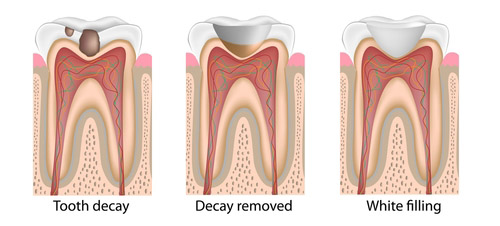The tooth filling (dental obturation) is a treatment focused on removing tooth decay and restoring the tooth when the damage has not been extended. It’s also applied after a trauma or an impact not affecting the nerve.
Tooth Filling or Dental Restoration?
The tooth filling, also known as obturation for dentists, is a type of dental restoration carried out when the damage in our tooth is not severe and does not affect the nerve.
In case the damage is produced in a molar and it is extended, a dental restoration must be applied. This may include the use of inlays, veneers or crowns to reinforce the molar, as it may crack easily.
If the damage produced by the trauma or decay has reached the nerve, a filling is not enough. We will need a root canal or an endodontics treatment. The proper thing is to do is visiting the dentist before it happens, this means before the pain forces us to do it.
Materials for a Tooth Filling
Silver amalgam: This material is very resistant, though its use has been reduced since its dark colour makes them unaesthetic.
Gold: It’s a quite proper and durable material but much more expensive than the other materials. Regarding aesthetics, it’s a matter of taste.
Composite or compound resin: This is the most used material since it imitates perfectly the appearance of a tooth. Its duration is shorter than that of an amalgam, but thanks to the last generation composites, the gap is narrowing.


Tooth filling step by step
The tooth filling treatment is a process which may take around 40 minutes in the dentist. In order to carry out an obturation, we will follow the next steps:
- Locating the core of the tooth decay. A probe and X-Ray are commonly used to check the real damage.
- The area is anesthetised. Not necessary if the damage is not severe and dentine is not affected.
- The damaged tooth or molar is isolated.
- The damaged area by the decay is removed. This process may be executed with rotating instruments or manually. Later on, the resulting cavity is properly cleaned.
- An adhesive gel is placed on the cavity.
- The cavity is later filled with the composite in the right colour, and it’s hardened with a led light.
- The occlusion is adjusted to assure a perfect result and the tooth fulfills its mission, biting and fitted to its opposite. To check it, the specialist carries out a bite test.


Does a tooth filling hurt?
It doesn’t. This procedure is usually performed with local anesthesia. We just need to be careful so we don’t bite ourselves during the anesthesia effects. The following days we may feel some extra sensitivity, but it will be gone. Tooth filling with no anesthesia is only performed when the damage is small and the process is not painful for the patient.
Is tooth filling safe during pregnancy?
Yes, it is, there is no problem at all, nor the procedure neither the anesthesia are affecting the baby. However, we need to be careful with X-Ray tests, and so this process is usually postponed after the breastfeeding period.
Keep in mind that during pregnancy, teeth may be more sensitive and hormonal changes may affect the composition of saliva, favouring tooth decay. It’s really important to extreme hygiene and, in case you are planning to become pregnant, a check up before pregnancy is the best thing to do.
Tooth filling in Artedental
In our dental clinic in Tenerife, we are committed to use the best materials, that’s why we use last generation composites based exclusively on ceramics with no classic monomers at all, present in other resins. A material with an outstanding biocompatibility, excellent physical properties and high stability to colour.
How much does a tooth filling cost in Artedental, Tenerife?
The price for a tooth filling in Artedental varies from 50 to 70 euros, though this costs rises depending on the complication of the treatment. The longer you wait, the more complicated it gets.
Do not hesitate and book an appointment in Artedental, in Tenerife, before the problem gets worse.
Images: Pinterest and MedHalt

